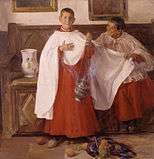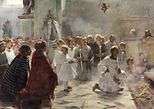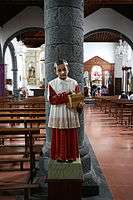Altar server
An altar server is a lay assistant to a member of the clergy during a Christian liturgy. An altar server attends to supporting tasks at the altar such as fetching and carrying, ringing the altar bell, among other things. A young male altar server is commonly called an altar boy, whereas a young female altar server is commonly called an altar girl.
Latin Catholic Church

Altar servers are a post-Trent innovation in parish churches. Formerly, professed acolytes performed these functions, except in women's monasteries where nuns substituted for acolytes. When priestly training developed in seminaries, professed acolytes were no longer available in parishes. So as in convents, substitutes called altar servers developed. In the parishes, only men and boys served at the altar, but canon 230 of the Code of Canon Law promulgated in 1983 allowed local ordinaries to permit girls and women to do so (see Female altar servers). In the United States, only the Diocese of Lincoln, Nebraska has not granted permission.[1] Even where the bishop grants permission, the priest in charge of a church is not obliged to avail of it. Traditionalist Catholic groups such as the FSSP and the Institute of Christ the King and some individual priests do not.
The term "acolyte" is sometimes applied to altar servers, but in the proper sense means someone who has been received the ministry of that name, usually reserved for those who are to be promoted to the permanent or transitory diaconate. These must receive the ministry of acolyte, which historically was classified as a minor order, at least six months before being ordained as deacons.[2]
Duties at Mass in the ordinary form of the Roman Rite
In the ordinary (normal) form of the Roman Rite of the celebration of Mass, provided no instituted acolyte is participating,[3] altar servers have the following responsibilities during:
- Entrance: Servers are to act as thurifer with burning incense (if incense is used at the Mass), as bearers of lighted candles flanking another carrying the cross and as other participants in the entrance procession.[4]
- Servers hold the liturgical books for the celebrant when he is not at the altar and is proclaiming the presidential prayers with outstretched hands. They bring and hold such things as books, thuribles, lavabo bowl and towel, patens, communion bowls, and microphones.[5]
- Proclamation of the Gospel: At the preceding Alleluia or other chant, the thurible is presented to the celebrant for him to put incense in it,[6] and then for the proclamation of the Gospel servers precede the priest or deacon to the ambo, perhaps carrying candles and incense.[7]
- Beginning of the Liturgy of the Eucharist: Servers arrange the corporal, the purificator(s), the chalice(s), the pall, and the Missal on the altar,[8] and then assist the celebrant in receiving the bread and wine and perhaps other gifts that are presented to him.[9] They present the cruets of wine and water for the celebrant or deacon to pour some into the chalice.[10] If incense is used, the thurible and incense are presented to the celebrant and, if there is no deacon, a server then incenses the celebrant, any concelebrants, and the people.[11] When the celebrant then washes his hands standing at the side of the altar, a server pours the water over them.[12]
- Consecration: The altar server shortly rings the consecration bells twice during the Epiklesis (to be rung when the priest lays his hands above the gifts immediately before the consecration). After each of the consecrations of the bread and wine, the bread and wine is then the Body, Blood, Soul, and Divinity of Christ. The altar servers ring the consecration bells shortly three times, at the elevation of both the Host and Chalice. If incense is used, a server incenses the consecrated host and the chalice while these are being elevated.[13]
- Sign of Peace: The servers may receive the sign of peace from the celebrant or deacon within the sanctuary.[14]
- Recessional: The servers lead the celebrant and any concelebrants as at the entrance procession.[15]
If a bishop celebrates Mass solemnly, two servers, wearing vimpas, hold the mitre and the crosier, and present them at the appropriate times. Servers may also be needed to carry a processional canopy (baldachin) during a procession with the Blessed Sacrament outside, as on the feast of Corpus Christi.
Duties at Mass in the extraordinary form of the Roman Rite

In the Tridentine Mass, the 1962 version of which is an authorized extraordinary form of the Roman Rite, altar servers have the following responsibilities at Low Mass and Missa Cantata.
- Mass of the Catechumens
- Processional: Servers carry the thurible, incense boat, processional cross and candles (flambeaux) in a Missa Cantata.
- After the sacristy bells are rung and first genuflection at the high altar, the server takes the priest's biretta, kisses it, and places on the Presidential Chair.
- Post-Epistle: Servers move Missal from Epistle side of the altar to the Gospel side of the altar.
- Mass of the Faithful
- Servers ring the altar bell once as the priest unveils the chalice and places the veil on the altar.
- Preparation of the chalice: Servers present the cruets of water and wine for the deacon or priest to pour in the chalice.
- Lavabo: A server administers the water to the priest as he ritually washes his hands.
- Beginning of the Sanctus: Altar bell is rung thrice.
- Canon of Mass: When the priest extends his hands over the chalice and begins the "Hanc igitur...", servers ring altar bell once, stand, take the bell, without genuflecting kneel on either side of the priest.
- Consecration: At each consecration servers make a deep bow at the priest's first genuflection, and ring the bell once. During each major elevation, servers kneel erect, raising the back of the chasuble and ringing the bell thrice. During the priest's second genuflection, servers release chasuble, make a deep bow and ring the bell once. After the consecration, holding the bell, servers return to their posts and kneel.
- Post Agnus Dei: Servers get patens from credence table and go back to posts with genuflections and kneeling. When the priest genuflects and says the triple "Domine, non sum dignus..." servers ring the bell thrice.
- Communion: Follow priest with paten in hand and hand over breast for the Communion.
- Ablutions: Get the water and wine cruets from credence table. For the first ablution at center of the altar, the server with the wine approaches as the priest tips the chalice toward the server. The server pours a little wine into the chalice, he bows and turns to his right and returns to the Epistle corner and wait for the priest. When the priest approaches for the second ablution, the server makes a moderate bow, pours a little wine over his fingers and then as much water as he desires. Then, with genuflections, switch the chalice veil from the Gospel side to the Epistle side with the Missal at the same time.
- Ending procession: Same as Processional.
Vestments
While ordained and instituted ministers must wear an alb (with cincture and amice unless the form of the alb makes these unnecessary), albs or any other appropriate attire, such as a cassock and surplice, may be worn by servers.[16] Black and red are the most common colors for a server's cassock, if used.
Eastern Orthodox and Eastern Catholic Churches

In the Eastern Orthodox Church, altar servers assist the higher clergy during services. They might carry the cross, candles or liturgical fans in processions and entrances; maintain the censer, ensuring it has enough live charcoal, loading it with incense and handing it to the priest or deacon when required; preparing the hot water (zeon) in time for it to be added to the chalice at the Divine Liturgy; prepare the antidoron for the people to receive after Holy Communion; and any other necessary tasks so that the celebrant need not be distracted during the service. An altar server is vested in the sticharion only.
In the early Church, before someone could be a server he had to be tonsured. Nowadays, in many places it is not necessary to be tonsured before one is allowed to serve (since the tonsure must be done by a bishop or higher-ranking priest). The rites of "Setting Aside a Taper-bearer" and "Tonsuring a Reader" have now been combined into one service. It is the custom in some traditions, such as the Greek Orthodox or Melkite Catholic, to allow tonsured altar servers to also vest in the orarion, worn crossed over the back like that of a subdeacon but with the ends hanging parallel in front. Among the Russians, however, the orarion is not usually worn by servers, but only by duly ordained subdeacons and deacons, with the exception that laymen who are blessed to perform some of the functions of subdeacons may sometimes be blessed to wear the orar.
Before vesting, the server must fold his sticharion and bring it to the priest for him to bless. The priest blesses and lays his hand on the folded sticharion. The server kisses the priest's hand and the Cross on the vestment, and then withdraws to vest. Any server who has not been tonsured must remove the sticharion when he receives Holy Communion, because communicants receive the Mysteries according to their order within the Church (so tonsured clergy vest while laymen remove their vestments). Before divesting at the end of the service, the server must receive the priest's blessing.
The minimum age varies by local circumstance, but boys must be mature enough to carry out their duties without disrupting the sanctity of the altar. Although it is common in North America for boys to act as altar servers, in some places this practice is virtually unknown and these duties are always carried out by adult men. In other places where altar servers are normally boys, adult men will not vest if called upon to serve. In yet other places, boys are not permitted to serve in the Altar on reaching their teens on the grounds that the young man is no longer innocent enough to serve in the altar.
Altar servers, regardless of age, are subject to all the normal restrictions for those not of higher clerical position. Anyone who is bleeding, or has an open sore, is not permitted to enter the altar. They may not touch the altar table or anything on it under any circumstances, nor the prothesis without a blessing. They may not touch the sacred vessels, the chalice and diskos (paten) at any time. They may not stand directly in front of the altar table or pass between the front of it and the iconostasis, but must cross between the altar and the High Place if they need to move to the opposite side.
In general, women do not serve in the altar except in women's monasteries. In that case they do not receive the clerical tonsure (though they must be tonsured nuns), and do not vest in the sticharion, but wear their normal religious habit for attending services, and serve at a certain distance from the actual altar table. Normally, only older nuns may serve in the altar; but the Hegumenia (Abbess) is permitted to enter even if she is younger. A few parishes have begun to use women as altar servers.
Other churches
In lower Anglican churches, most Lutheran Churches, and in the Methodist Church, all who serve in the above positions are called acolytes.
In Anglo-Catholic and some Episcopal Churches however, the vast majority of roles associated with an altar server are the same as those in the Catholic Church, and the same titles for each individual role are retained from Catholic tradition – mostly restored during the Oxford Movement in the 19th century.
- Altar servers in art
-

Altar server, by Giacomo di Chirico
-

Escolanets, by José Benlliure y Gil
-

Ministranten beim Gebet by Felix von Ende, ca.1888
-

Palm Sunday mass by Zdzisław Jasiński, 1891
-

Statue of an altar server in the Iglesia de San Ginés in Arrecife, Lanzarote
References
- ↑ "USATODAY.com - Neb. diocese is lone U.S. holdout on allowing altar girls". usatoday.com.
- ↑ "Code of Canon Law - IntraText". vatican.va.
- ↑ "General Instruction of the Roman Missal, no. 100" (PDF). liturgyoffice.org.uk.
- ↑ General Instruction of the Roman Missal, no. 120
- ↑ "Catholic Bishops' Conference of England & Wales, Celebrating the Mass: A Pastoral Introduction (Catholic Truth Society 2005), p. 19" (PDF). liturgyoffice.org.uk.
- ↑ General Instruction of the Roman Missal, no. 132
- ↑ General Instruction of the Roman Missal, nos. 133, 175
- ↑ General Instruction of the Roman Missal, no. 139
- ↑ General Instruction of the Roman Missal, no. 140
- ↑ General Instruction of the Roman Missal, no 142
- ↑ General Instruction of the Roman Missal, nos. 144, 178
- ↑ General Instruction of the Roman Missal, no. 145
- ↑ General Instruction of the Roman Missal, no. 150
- ↑ General Instruction of the Roman Missal, nos. 154, 181
- ↑ General Instruction of the Roman Missal, no. 169
- ↑ General Instruction of the Roman Missal, nos. 119, 336
External links
| Wikimedia Commons has media related to Altar servers. |
- Photo of Russian Orthodox bishop surrounded by servers
- SanctaMissa.org's Online Altar Server Tutorial with Video and Guides (1962 Roman Missal)
- Altar Server Guide
- Parent's Training Manual for Altar Servers Gives parents tips on how to prepare their children for serving at the altar
- Another Altar Server Manual
- Official Website of the Ministry of Altar Servers San Roque Cathedral, Diocese of Caloocan, Philippines
- Official Website of the Ministry of Altar Servers of Sto. Niño Parish, Taguig City, Philippines